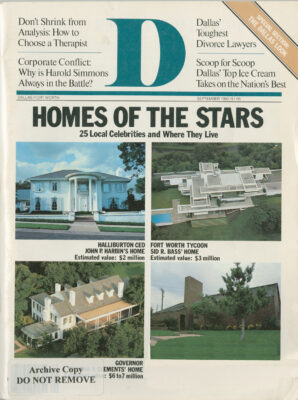A year ago, the big cable news around Dallas was that the franchise fight was over and that we would soon be blessed with 80 channels of cable television. Since then, Dallasites have been hearing about satellites, supertrunks, coaxial cables, hubs, spokes and rims. Now, yet another term has been added to the cable lingo: fiber optics. Along with the new term came the news that fiber optics might replace a part of the current Warner Amex system. And questions followed: “Will this new technology slow down the building of the system?” “Will it be another two years before we’re able to gorge ourselves on movies in the privacy of our own living rooms?”
The response is, relax. Anne Hall, senior vice president of corporate affairs for Warner Amex, says the change to fiber optics won’t directly affect the consumer. In the long run, though, it will ensure that Dallas has up-to-date and efficient cable television.
When Warner Amex was competing for the Dallas franchise, it proposed use of a system based upon the model of a wheel. Super-trunk coaxial cables linked the system, and microwaves were to be used as a backup or “redundancy” system to prevent blackouts. Then there was the third link, which connected the cables to individual houses. At the time of the franchise bidding, fiber optics, in the opinion of Warner Amex, was not developed enough to be used in the system. Recently, though, the company has declared fiber optics “state-of-the-art technology.”
In August, the City Council passed a proposal to hire a consultant (at Warner Amex’s expense) to perform a feasibility study on the replacement of coaxial cable with fiber-optic cable, and to build a test line of cable that would link downtown to the main cable artery. The council will either approve or reject fiber optics in April 1984.
But that doesn’t mean we have to do without cable until then. Until a decision is reached concerning fiber optics, the microwave backup system will be used, and houses will continue to be plugged into the system. Though Warner Amex prefers a hard-wire system (such as the supertrunk), the company claims that microwave will be sufficient during the test period and that many cities (such as Fort Worth) use microwave for their main system.
At this point, there’s increasing agreement that the advantages of fiber optics outweigh the disadvantages. With coaxial cables, an amplifier is needed between every 2,100 feet of cable. The amplifiers must be out-of-doors and are therefore vulnerable to harsh environmental factors. With fiber optics, these outside amplifiers aren’t needed, and all of the electronics are housed in buildings. A disadvantage of fiber optics is the possible high repair cost since the fibers are hairlike and require light for transmission; if there is a breakage, splicing is a highly technical, expensive endeavor. Coaxial cables are made of copper, and according to Tom James, director of public utilities for Dallas, with the rising cost of this metal, coaxial repairs will cost about the same as fiberoptic repairs. In the future, the cost of fiber-optic repairs should decrease with improved technology.
Another advantage of fiber optics is the number of channels that can be transmitted on each cable. The current system has the capacity to carry 100 channels. Fiberoptic cables can carry 240 channels.
When Warner Amex declared fiber optics state-of-the-art, Dallas’ system, the largest in the country, was still in a stage where the switchover from coaxial to fiber optics was feasible. If the system had been any more mature, the switchover would not be cost-efficient. At this point, only 17 miles of coaxial cable have been laid. It will be replaced with the new cable if fiber optics are approved by the City Council.
Related Articles

Home & Garden
A Look Into the Life of Bowie House’s Jo Ellard
Bowie House owner Jo Ellard has amassed an impressive assemblage of accolades and occupations. Her latest endeavor showcases another prized collection: her art.
By Kendall Morgan

Dallas History
D Magazine’s 50 Greatest Stories: Cullen Davis Finds God as the ‘Evangelical New Right’ Rises
The richest man to be tried for murder falls in with a new clique of ambitious Tarrant County evangelicals.
By Matt Goodman

Home & Garden
The One Thing Bryan Yates Would Save in a Fire
We asked Bryan Yates of Yates Desygn: Aside from people and pictures, what’s the one thing you’d save in a fire?
By Jessica Otte


